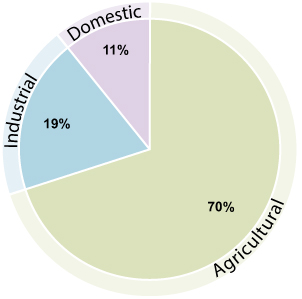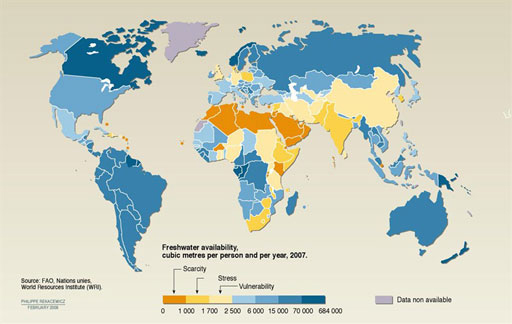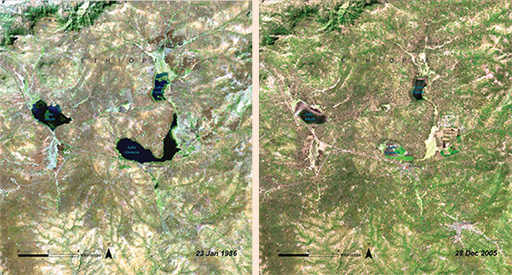1.2.3 Water resources
You may have noticed that the four categories of resources shown in Figure 1.2 do not include water, and yet this is one of our most vital resources and is obviously central to the WASH sector. The direct use of water by people falls into three main categories:
- domestic uses, including drinking, washing and cooking
- agricultural uses, principally irrigation
- industrial uses, in manufacturing processes and for energy generation.
The relative proportions of these three categories vary in different parts of the world, but globally the sector using the most water is agriculture (FAO, 2012) (Figure 1.5).

As well as direct use of water for human activities, water is also essential for the environment and to maintain biodiversity. Rivers, lakes and wetlands are important habitats for wildlife and need a minimum amount of water at all times. This becomes a problem when the demand for water for human activities exceeds the supply.
Water is not an endlessly renewable resource. In many parts of the world water demand is significantly above sustainable water supply. Sustainable water supply means there are adequate supplies, in both quality and quantity, to meet the current and future needs of people and of the environment.
Many countries are already experiencing water stress or scarcity. These terms refer to the volume of water available relative to the use and demand for it, which is linked to the population served. Figure 1.6 shows the availability of freshwater across the world. Countries which have less than 1700 m3 of water per person per year for all purposes are defined as water stressed (United Nations, 2014). Water scarce countries have been defined as those with less than 1000 m3 of water per person per year. These precise figures should be used with caution, however, because they do not recognise variations between countries and they hide the underlying causes of water scarcity.

Increasing water demand leads to unsustainable use of water resources. By the actions of the water cycle (which you will learn about in Study Session 4) water supply is replenished, but taking excessive amounts of water from rivers and groundwater for domestic, industrial and agricultural use decreases the amount of water available for current and future generations. Globally, water withdrawals have tripled over the last 50 years due to population growth and to increased consumption per person. Many areas with plentiful supplies can sustain this use, but in some countries the future may bring water shortages unless demand is managed.
If the trend for increased consumption continues, what could be the result for Ethiopia?
As you can see from Figure 1.6, Ethiopia is already classed as being under water stress. If consumption increases due to population growth and/or increased use per person, this could put Ethiopia into the water scarcity category.
In practice, for Ethiopia, the problem of water supply is not so much about the volume of water that is available. The problem is the infrastructure and investment required in delivering adequate quantities of safe water to all the people wherever they live. The availability of water and access to a safe supply varies considerably throughout the country and between rural and urban populations.
Case Study 1.1 illustrates the problems that can arise from excessive water use.
Case Study 1.1 Effects of water use on Lake Alemaya
Lake Alemaya in the Ethiopian Highlands has always provided local people with water for drinking and domestic use, for irrigating crops, watering livestock and fishing. In the mid-1980s it was around 8 m deep and covered 4.72 km2. However, by 2005 the amount of water in the lake had dropped dramatically (Figure 1.7) and the size of the lake had fallen (UNEP, n.d. 2).
It is believed that changes in water use by local people and changes in the local climate are responsible. The use of domestic water and also water for irrigation (especially for growing khat) has increased significantly. Deforestation of the surrounding area, as land is cleared for farming and to meet an increasing need for wood, means that tree roots no longer hold the soil together and it is washed off the hillsides into the lake. This causes it to silt up and reduces the capacity of the lake. Warming of the local climate may also have had an effect, increasing the rate of evaporation from the lake. Recently, lack of water in the lake has interrupted water supply to Harar, a nearby town of over 100,000 people.
What are the possible causes of the loss of water from Lake Alemaya?
Increased use of water for domestic uses and for irrigation, deforestation leading to soil erosion and silt deposition in the lake, and possibly climate change.
1.2.2 Energy resources

